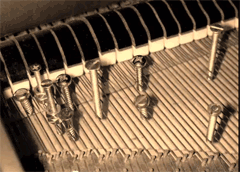

John Cage - Prepared Piano (1946-1948) (14:13) play to 0:30, then start at 10:48
Schaeffer stated: "when I proposed the term 'musique concrète,' I intended … to point out an opposition with the way musical work usually goes. Instead of notating musical ideas on paper with the symbols of solfege and entrusting their realization to well-known instruments, the question was to collect concrete sounds, wherever they came from, and to abstract the musical values they were potentially containing"... Schaeffer had developed an aesthetic that was centred upon the use of sound as a primary compositional resource. The aesthetic also emphasised the importance of play (jeu) in the practice of sound based composition. http://en.wikipedia.org/wiki/Musique_concrète
Etude de Chemin de Fer (2:54)
'Using disk lathes, Schaeffer went to locales like the Batignolle Railway Station and etched the rumble of trains into the record's grooves. ... Schaeffer wanted to remove the original meanings and definitions of his sounds and create a deeper psychological-emotional response. In works such as Etude aux Chemins de Fer (Etude on Railroads) ... the sounds were familiar, but rearranged into bizarre juxtapositions, in the surrealist style of the era. The techniques of speeding up, slowing down, reversing, editing, and looping were all used to create sonic "collages," as Schaeffer calls them, all before the advent of tape recorders, let alone digital samplers.
After recording their sounds, they went back into the studio and isolated them, re-recording them onto other disks with different manipulations, including what they called "the locked groove:" putting an intentional skip in the record so a sound would be repeated, not unlike a tape loop or sequencer. Schaeffer describes the recording process. "We would have seven or eight turntables playing together, but with only one sound playing on each. Then we would try different variations, montages with let's say, sound 'A' repeated twice, then a sound 'B' then 'C' repeated and so on. It was similar to an orchestra rehearsal where you would be trying different themes, different variations."'
http://www.emusician.com/features-interviews/0777/pierre-schaeffer--pierre-henry-pioneers-in-sampling/146377
In Cologne, what would become the most famous electronic music studio in the world was officially opened ... it had been in the planning stages as early as 1950 and early compositions were made and broadcast in 1951 ... the idea [was] to synthesize music entirely from electronically produced signals; in this way, elektronische Musik was sharply differentiated from French musique concrète, which used sounds recorded from acoustical sources. http://en.wikipedia.org/wiki/Electronic_music#Electroacoustic_tape_music
Elektronische Musik Studie I (9:23) - manipulated sine waves.
Studie II (2:58) The first electronic piece with a score - subtractive synthesis
Artikulation (3:53) 3rd party graphical score added later
from the original press release... "Most homemakers are used to wheeling their cleaning equipment with them from room to room -- why not do the same for the entertainment unit that helps to lighten her tasks as much as her vacuum cleaner or her floor waxer? Pictured are the essential ingredients for a simple portable hi-fi system that can be moved from room to room with ease. The idea is of interest to the audio dealer as an unusual and salable merchandising gimmick and to the audiophile as a convenient method of mounting standard components to provide portability to his hi-fi system. Before our eagle-eyed reader-technicians swamp us with letters pointing out the missing interconnections, may we say that Mrs. Audiophile has just been surprised with this exciting Christmas present from Hubby and he refuses to hook it up until he gets outside of his turkey dinner." http://www.shorpy.com/node/532
The Music and SFX of Forbidden Planet - First electronic film score
Forbidden Planet - Whole Soundtrack Album
Dripsody (1:29)
This is a summary of notes taken from Schrader, Barry (1981) Introduction to Electroacoustic Music, Englewood Cliffs, New Jersey: Prentice-Hall http://www.amhiggins.ie/artefact2004/documents/dripsody.pdf
Thema (Omaggio a Joyce) (8:12) (clips at opening, 2:10, 3:16, 5:11, 5:28, 6:04)
For mezzo-soprano and tape. Luciano Berio's Thema Realized in 1958 at the Studio di Fonologia, Thema is one of Berio's electronic/tape pieces, and takes the "Sirens" chapter of Ulysses as its source material.
The work opens simply, with Berio's wife Cathy Berberian reading the opening text from "Sirens." Eventually her agile voice is subjected, at first subtly, to amplification and slight distortion, until her final "hissss" opens the doors fully to Berio's technological manipulations.
Although there are no electronically generated sounds per se, her reading is used as the material for a bizarre fugal exploration that eventually renders the text unrecognizable. The applied effects are myriad: distortions, echoes, stutterings; the tape speeds up, slows down; multi-trackings and splicings modulate her voice from incoherence to layered beauty. At times it achieves a spooky otherworldliness; at others it sounds like a tape machine having a particularly bad nightmare.
To modern ears, used to Pink Floyd, trip-hop and electronica, it seems almost quaintly outdated; but nevertheless it is certainly due respect, for both its avant-garde spirit as well as the ingenuity it expresses in its limited medium.
And even given its technologically dated nature, it's still an impressive accomplishment, and makes for a bizarre and intriguing listening experience, blurring the borders between language and sound. http://www.themodernword.com/joyce/music/berio_thema.html
Revised John Ellinger, January - September 2013